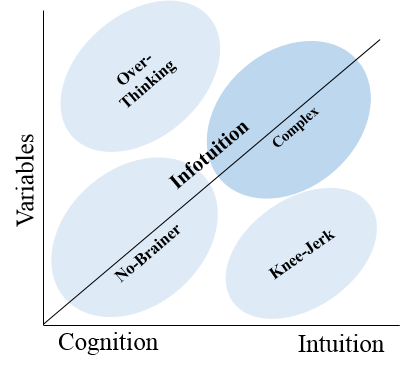Do you want to make more insightful decisions? As you move from management into leadership you face increasingly complex decisions that are filled with ambiguity, uncertainty and risk. The number of variables to be considered grows from few to many adding complexity. This is the nature of leadership decision-making.
Successful leaders call on vast information resources to make decisions. They gather as much information as possible within time constraints and they pay attention to their intuition. At the decision point, cognition and intuition are balanced through an internal calculus appropriate for the situation. This balance point is what I call infotuition™. Below is a graphical depiction.
In 1996, Kenneth Hammond put forward a similar theory that he called the Cognitive Continuum Theory. Spinoza, in the 1600s, predated Hammond by several centuries when he said, “Intellect brings the observer to the point where intuition must occur.” With the advent of the scientific method, intuition fell out of fashion as increasing value was placed on rational thought. Today, due in part to advances in neuroscience, the wisdom available through intuition is coming back to the fore.
Personal interviews with over 70 leaders from the public, private, academic, nonprofit and political sectors on the role of intuition in leadership led to the following decision-making framework. The Infotuition™ Cognition-Intuition Balance Model arrays the continuum of cognition and intuition with the number of variables in the decision. Within that framework, four types of decision-making approaches are identified. Let’s look briefly at each type.
As expected, simple decisions can comfortably be made using predominantly cognitive processing, hence, they are no-brainers. Leaders frequently delegate these decisions as they are more easily quantified or bounded by policy and procedure.
Decision-making become more difficult as the number of variables exceeds the brain’s cognitive processing capability. If you persist with cognitive processing only you experience over-thinking. Over-thinking, also known as analysis paralysis, is repetitive mental churning in search of a logical resolution. Here are a few indicators of over-thinking.
¨ Data and analysis may shut out other intangible considerations
¨ The decision is postponed while seeking more information
¨ The time spent in decision-making exceeds the value of the decision
¨ Nagging feelings are shoved aside to “think it through”
Perhaps, you work with a leader who makes “knee-jerk” decisions or “shoots from the hip.” This type of decision is made without considering all available information. The truth is that you, too, make knee-jerk decisions. Knee-jerk decisions come from habits or triggers that cause an emotional reaction rather than an appropriately considered response. There are powerful circuits in the brain that make habits easy. Without self-awareness knee-jerk reactions can lead to inappropriate decisions. These are early-warning signs.
¨ There is quick reaction without hearing available information
¨ You over-react to a situation
¨ There is strong emotion behind the decision
¨ Available information and others’ input are discounted
Before moving on to complex decision-making, let’s look briefly at how to move from unproductive decision-making into balanced decision-making that uses both cognition and intuition.
To move from over-thinking to complex decision-making, think about thinking too much. It seems, well, counter-intuitive, but you must first recognize the signs of over-thinking. Ask, “Have I considered all available information? What’s the risk of delaying the decision while gathering more data?” Once you acknowledge that you are over-thinking, then you are ready to incorporate more intuition. Ask, “What’s bothering me about this decision?” Notice the feeling and give it a name. Examine the source of your discomfort. Give yourself permission to consider your feelings as part of the decision-making process. Try it, make the decision and evaluate the results afterwards.
The key to moving from knee-jerk to complex decision-making is to recognize the early warning signs in your body. Situations that trigger your reaction will first surface as a bodily sensation – queasy gut, tight chest, clenched jaw. When you recognize the sensation, pause and take a break. Give yourself some space to slow your reaction. Explore your feelings and ask, “Why do I feel so strongly? What’s my motivation?” Once you are calm, incorporate more thinking. “Have I objectively considered everything? Have I heard views from others?” Acknowledge your feelings, incorporate logic and make a more balanced decision.
The most constructive decision-making appropriately balances complexity with cognition and intuition. The more variables, the less likely that the brain can cognitively reach a sound conclusion. Fortunately, the brain is designed to integrate disparate information both cognitively and intuitively into an insightful decision – if you let it.
In complex decision-making leaders use techniques to decrease complexity; they notice and validate their feelings; and they use the brain’s natural ability to process vast amounts of information unconsciously to reach a decision using infotuition™.
Leaders have various methods to reduce complexity.
- The most common is experience. The more diverse experiences, the more variables leaders can account for.
- Less discussed but exhibited by the majority of leaders interviewed is self–awareness. Self-awareness provides underlying principles, values and personal boundaries for the decision.
- Leaders carefully weigh risk and balance rigor with decision speed.
- Leaders read and understand people which mitigates some variables.
- Simplification of the issue helps leaders to strip away variables that are less important and provides more clarity about the desired outcome.
- Successful leaders are constantly aware of the big picture. They are aware of the environment, situational context and trends.
- Leaders, of course, consider facts and analysis, as one but not the only variable, and they take into account the source of the analysis.
Complex decision-makers are aware of their feelings. They notice when their body nudges them that something seems amiss. The feeling may cause them to probe further, ask more questions or reconsider their approach. Their feelings indicate when the timing is right for a decision and which decision to choose. They view feelings as a valid input into the decision-making process.
Finally, they step away. The part of the brain that is adept at processing large amounts of information works particularly well when given some space and quiet. Leaders “sleep on it,” exercise, do something to give their brain a break from the decision. Characteristics of complex decisions include:
¨ All facets of the decision both tangible and intangible are assessed
¨ The objective of the decision is separated from extraneous information
¨ Feelings about the decision are recognized and considered
¨ Space is provided for creative processing of cognitive and intuitive inputs
¨ The final decision is grounded in infotuition™
Lastly, complex decision-making can be learned with practice. Due to the plasticity of the brain, the brain can be trained with attention and repetition to notice feelings, develop the capacity to pause when a trigger happens, and to creatively process information. Leaders say that they learned to trust their intuition. While not infallible, they use it, observe the results and learn for the next time.
Spinoza was right. With what is known today, it is illogical not to incorporate the power in the brain and body for faster, smarter and more insightful decisions. Infotuition™ is a business and life skill. You’ve got it. Are you using it?








0 Comments